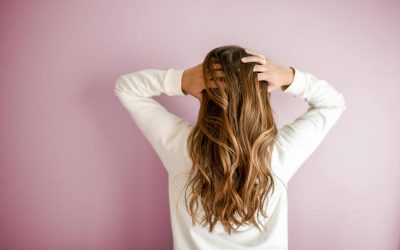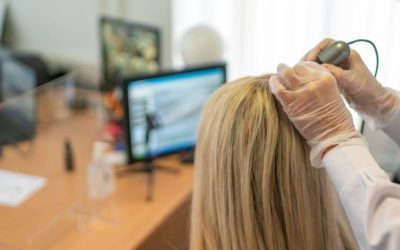You’ve been juggling deadlines, dealing with family pressures, navigating uncertain times, and lately, something feels off. Your hair feels thinner. You find more strands on your pillow, in the shower, or stuck to your hairbrush. You ask yourself: Could this be hair loss from stress?
It’s a question worth exploring. Stress-related hair loss is real, and understanding how it shows up is the first step toward preventing it from defining your weeks, months, or even years. Let’s dive into what stress-related hair loss looks like, why it happens, how to spot it early, and when it’s time to seek expert help.
Spotlight on Stress: The Hidden Hair Loss Culprit
Stress triggers a cascade of invisible changes across your body. It’s not just about mood or sleep; stress affects hormone levels, blood flow, and even the natural hair cycle. A prolonged period of high cortisol, your primary stress hormone, can throw your hair into different, unsettling stages:
- In telogen effluvium, a large number of hairs simultaneously enter the resting phase and shed weeks later.
- In alopecia areata, stress sometimes triggers the immune system into attacking hair follicles, causing patchy bald spots.
- And if you’re already genetically predisposed to male or female pattern baldness, stress can accelerate the thinning and make shedding feel more intense.
Recognising the link between stress and your hair isn’t just about what’s happening physically—it’s about connecting the dots between your feelings, your hair, and your timeline.
What Hair Loss from Stress Typically Looks Like
You don’t need to detach clumps to know stress is affecting your hair. In many cases, you’ll first notice a gradual thinning across your scalp. Your part might look wider, or the ponytail might feel less full. You may spot more strands collecting around the sink or in your hairbrush.
If you look closer, you might detect subtle signals: less hair at the temples, a gently receding hairline, or thinning where it was once thick. With alopecia areata, you might notice clean, round patches.
The key sign of hair loss from stress isn’t just the shedding, it’s also the timing. You might remember a stressful event or month, and see thinning 2–4 months later. That lag happens because hair takes time to move through growth cycles. Spotting patterns is how you catch stress-related loss before other factors take over.
Why Your Hair Actually Stops Growing
On a biological level, stress tells your hair to “freeze.” During stressful periods, your body shifts resources away from “non-essential” systems, like hair growth, and towards survival systems. That means hair follicles take a hit, slowing down or stopping.
At the cellular level, stress can tighten blood vessels and reduce oxygen delivery to follicles. Nutrients don’t reach them like before. Prolonged stress can even quiet down stem cells that drive hair regeneration.
When you understand this, you see why emotional health and stress management are part of the solution, not just topical treatments and vitamins.
When Hair Loss from Stress Becomes More Than Cosmetic
Losing a few strands? Probably nothing to worry about. But if you feel alarmed, you’re right to take it seriously. Heavy, persistent shedding (think: fistfuls in the shower), noticeable patchiness, or rapidly thinning areas should be seen as early warning signs, not vanity.
What’s important is consistency and awareness. Are you consistently losing more hair than usual? Do you feel your overall enjoyment of life is dipping? Are you noticing more strands in places where you didn’t before? Even if it’s not dramatic, seeing a hairstylist or clinic early can prevent things from slipping further.
What You Can Do Right Now to Check for Stress-Related Loss
First step: pause and observe. Let your awareness be your diagnostic tool. Before or after showering, muse on how full your hair feels as you comb it. Make a before-photo note of your part, your ponytail volume, or any patchiness you suspect.
Hair loss from stress often presents as diffuse shedding, affecting large areas evenly rather than sudden chunks. If you’ve been through something stressful—illness, high-pressure work, emotional events—and you now notice more strands, it’s a pattern worth tracking.
You might also try a gentle hair pull test: grasp about 30 strands at the root and tug lightly. Finding more than 3–5 hairs may suggest shedding beyond normal turnover. Don’t obsess over every pull test, but create a habit of gentle, periodic checks to understand your baseline.
Self-Care Practices That Support Hair Health
If you suspect hair loss from stress, the good news is that your own habits can make a difference for both scalp health and your peace of mind.
Start with simple self-care rituals:
- Daily breathing breaks, mindfulness apps, or walks in nature do wonders for cortisol resets.
- Keep hydrated and aim for balanced meals: leafy greens, protein, healthy fats. Your hair needs building blocks.
- Reduce caffeine or quick sugar rituals. It might calm your stress and your hormones.
- Get 7–8 hours of sleep. Even half an hour more can anchor your hair back into growth mode.
- Take a break from heat styling, tight hairstyles, or chemical treatments. Let your hair and scalp breathe.
And while these won’t reverse everything overnight, they set the stage for recovery, while reducing ongoing damage.
When to Consult a Hair Loss Specialist
Your home routine is essential, but if you’re dealing with persistent shedding or unusual patterns (e.g. bald patches, rapid thinning), it’s time to book a professional consultation.
Specialist hair clinics, like Dublin’s Universal Hair Clinic, aren’t just for transplants. Their trichologists (hair and scalp experts) use tools like digital dermoscopy to assess follicle health, measure hair density, identify inflammation, and treat underlying scalp issues.
They’ll interview you about your stress history, diet, lifestyle, and past concerns. Their snapshot helps draw a realistic roadmap: Is this stress-related, male pattern alopecia, or a scalp condition? And what treatments are the next steps?
Even simple interventions, like a series of low-level laser therapy sessions, tailored supplements, or antioxidant scalp care, can shift hair back into growth with professional oversight.
What a Consultation at a Hair Clinic Might Look Like
It usually begins with a trichologist-led consultation and scalp scan. Working with minimal shedding, they’ll detect miniaturised hairs and signs of follicle stress. They examine scalp health, checking for sensitivity, inflammation, and flakiness.
Expect a calm conversation that explores your stress timeline: recent burnout, loss, work overload, and health issues. All these are part of the story. When they link stress events to shedding onset, that helps tailor your treatment plan.
Solutions range from nutritional support (iron, zinc, vitamin D), topical treatments to limit inflammation, LLLT to stimulate follicles and improve scalp blood flow, and scalp therapies to rebuild healthy barriers. It isn’t about surgery at all—it’s about unlocking your body’s own recovery capacity.
How Treatment Helps Reverse Stress-Related Hair Loss
Once follicles decide to pause, they need signals that it’s safe to restart. By combining stress-reduction, nutrition, and targeted scalp care, you start rebuilding.
Hair growth is gradual, so patience is part of the process. Visible regrowth usually begins around the 3–6 month mark, with faster hair becoming longer and thicker over time. Follow-ups every few months help adjust your plan until your scalp feels vital again.
Creating a Stress-Resilient Lifestyle for Hair and Mind
Even after regrowth, your scalp will thank you for a resilient lifestyle. That means more than just scalp creams—it means mindset shifts:
- Plan for small stress vacations: no phone, no news.
- Prioritise hobbies, movement, art, music, that activate your parasympathetic system.
- Surround yourself with friends, community, and therapeutic routines.
- Notice when stress and scalp reactions align: anxiety flares, you find thinner patches again.
Resilience isn’t a one-time fix, it’s a cultivated muscle. Your scalp and your emotional wellbeing thrive over time.
What to Do if You Think You’re Losing Hair from Stress
If reading this feels like you’re describing your own experience, here’s a narrative roadmap:
Start with awareness. Track hair loss, journaling moments you notice increased shedding or scalp shifts.
Launch gentle self-care: balanced meals, sleep hygiene, daily breath breaks, supportive conversation.
Book a trichologist consultation, just one appointment to give perspective. At Universal Hair Clinic, many early-stage cases restore without needing medicated courses. We give you options, not scripts.
Trust the journey: growth on hair isn’t linear, but every month you invest, you’re supporting the foundation of your hair story. And even if it doesn’t always pan out perfectly, the improvement in your well-being is worth it all, because stress shrinks with awareness, even before hair grows back.
Hair loss from stress is common and often reversible. But change requires action. Ignoring it may allow it to become permanent. Awareness, self-care, and the right help create a hopeful pathway.
Your hair holds clues, but it’s your life that needs attention. If your scalp is signalling distress, listen. Protect your peace. Nurture your hair. And with time, both can grow stronger.
Would you like to know more about hair loss causes and treatments? Our team is available to respond to your queries. Call us at +353 (0)1 679 3618 or click here to reach us today!



